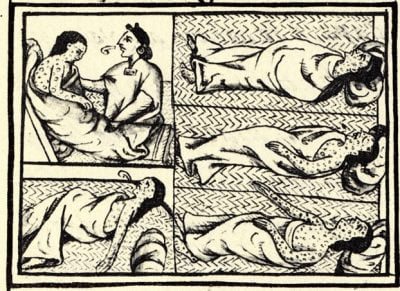#106 Devastation beyond germs
Beyond Germs: Native Depopulation in North America
Catherine M. Cameron, Paul Kelton, and Alan C. Swedlund (editors)
Tucson: University of Arizona Press, 2015
U.S. $29.95 / 9780816535545
Reviewed by Jody Decker
First published March 18, 2017
*
As a follow-up to Courtney Kirk’s review of Tom Swanky’s controversial The Smallpox War in Nuxalk Territory [See Ormsby Review #103, Tainted blanket, tainted history], Jody Decker responds to a much broader perspective from three editors who have gathered proceedings from a multi-disciplinary conference.
In a book that makes grim reading, the authors and editors of Beyond Germs: Native Depopulation in North America argue that the “virgin soil hypothesis” does not in itself explain the Native depopulation of the Americas after contact. A virgin soil epidemic occurs in populations with no prior exposure, and therefore no immunity, to European diseases such as smallpox or measles.
While not wanting to deny the devastating effect of introduced diseases, the contributors to Beyond Germs also point to the negative impact, at various times and places, of colonial policies including land expropriation, violence and warfare, forced labour and enslavement, population dislocation, and outright genocide. Therefore it is simplistic to blame Native depopulation solely on the introduction of European germs, and such an approach absolves settler cultures from acknowledging other malignant consequences of colonialism.
Reviewer Jody Decker points out “that despite various challenges, most Indigenous groups displayed impressive resilience, perseverance, and a range of inventive adaptive strategies.” – Ed.
*
 This book is a compilation of articles resulting from an Amerind Foundation Anthropology Seminar that brought together ten North American multidisciplinary scholars (although they are primarily anthropologists with varying research interests) to re-examine “virgin soil” disease theories and their impacts on American Indian mortality.
This book is a compilation of articles resulting from an Amerind Foundation Anthropology Seminar that brought together ten North American multidisciplinary scholars (although they are primarily anthropologists with varying research interests) to re-examine “virgin soil” disease theories and their impacts on American Indian mortality.
The majority of the ten essays focus geographically on present-day U.S. regions such as the southeast, the midcontinent, or the Connecticut River Valley region. Three of the articles focus on former Spanish missions in Florida, the U.S. Southwest, and California. There are only scant references to present day Canada. The sole article on Mexico by Gerardo Gutierrez does not directly discuss disease issues, but presents a detailed, absorbing account of the Spanish caste system and identity erasure among Mexican indigenous populations.

The concept of “beyond germs” has been applied as an explanation for Native depopulation for decades. With new evidence, improved methodologies and a broader assortment of researchers, this concept continues to be reassessed and expanded. Two of the chapters in this volume, David Jones’s opening essay on “Death, Uncertainty and Rhetoric,” and Clark Spencer Larsen’s chapter on “Colonialism and Decline in the American Southeast,” are extensions of their previously published works, both espousing the concept of “beyond germs.”
In an article in the William and Mary Quarterly, “Virgin Soils Revisited,” for example, Jones specifically analyzed the roles immunological deterministic theory and genetic susceptibility played in American Indian susceptibility to European pathogens. It was not simply lack of immunity that led to depopulation, he argued, but rather a combination of immunity and genetics, along with social, cultural, and environmental factors, such as poverty, famine, warfare, or dislocation.[1]

In Beyond Germs, Jones provides an updated review and often scathing critique of both scholarly and popular narratives written on the epidemiological consequences of European arrival to North America. His work typifies this book’s central argument: disease played a role in depopulation, but was not necessarily the dominant factor.
There are several competing hypotheses for explanations of Native depopulation. The earliest explanations from scholars such as Alfred Crosby and Henry Dobyns, writing in the 1960s and 1970s, were grand narratives about epidemics such as smallpox that swept through “virgin-soil” populations that had limited or no immunity to European diseases, and which resulted in wide-spread, catastrophic collapses in populations.
This scholarship led to debates over the magnitude, timing, and rate of decline from such epidemics, but was impeded by inexact or unknown prehistoric and historic population sizes. The so-called “high counters” espoused the highest pre-contact population figures and huge losses from infectious disease outbreaks. Their works, however, were largely discredited when smaller scale studies revealed that population declines and recoveries varied temporally and spatially all over North America.

Debates then arose as to the relative contribution of ancillary factors to disease theories such as warfare, migration, dispersions, slavery, and colonization. This shift from quantitatively based explanations to more nuanced qualitative studies revealed a far more complex picture of Indigenous societies, pre- and post-contact. This collection of articles is heavily based on qualitative analyses and aptly demonstrates that despite various challenges, most Indigenous groups displayed impressive resilience, perseverance, and a range of inventive adaptive strategies.
Explanations based on subjugation and exploitation from colonization became the second main thrust in depopulation debates. This volume contains four notable examples. Paul Kelton shows how colonialism escalated violence and war toward the Cherokee people, which did more to depopulate them than smallpox outbreaks.
In his article on the effects of Spanish colonialism, Clark Larsen argues that La Florida is an exemplar of structural violence, “… a collective of social structures, institutions, and policies that suppress the ability of members of Native societies to reach their full potential” (p. 88).

Debra Martin takes the notion of structural violence one step further and argues that “creeping genocide” from culturally and politically motivated practices set up by the colonists became more of a challenge for the Southwest Native groups than did epidemics.
And finally, in her article on usage of the community as an analytic framework to explore Native experience and response to disease, Kathleen Hull effectively argues how this entity became a valuable strategy for survival outside of colonial institutions.
A third set of hypotheses, barely touched on in this volume, centres on ecological and environmental explanations. Examples such as famine from crop failures, which led to migrations and seasonal utilization of various environments by some Native groups, opened the door, wrongly, to explanations of such groups being wiped out. George Milner’s article on midcontinent and eastern woodlands population decline makes this point.
The final set of hypotheses searching for explanations into population declines concerns assumptions drawn from data and demographic models over the numbers, the evidence, the inferences, the computation of reproductive rates, and changes in population structures. When David Henige published his 1998 book: Numbers from Nowhere: The American Indian Contact Population Debate, his acerbic comments on “high counters” and convincing arguments on widespread misuse of evidence in Native depopulation debates, were eye-opening and frankly necessary.[2]

Many of the authors in this volume also bemoan the continued usage of problematic evidence, most notably Swedlund in his analysis of Native depopulation in New England. As he notes, researchers often have to rely on historical reports when physical evidence is not available, but when faced with wide-ranging figures that “while suggestive, … are inadequate to the task of making rigorous conclusions about the true magnitude of population in the region” (p. 150).
While this volume succeeds in convincing researchers that the depopulation debate has evolved, public discourse continues to frame it as an Indigenous problem. The disputed findings of the “high counters” and their microbial-centred, virgin soil arguments have been allayed, but not totally put to rest.
In Beyond Germs, the criticisms for this are re-directed at popular writers such as geographer Jared Diamond and science journalist Charles Mann, whom Jones effectively bashes in his essay on “Death, Uncertainty, and Rhetoric.”

Both these well-known authors have reached wide audiences though their published books, Diamond’s Guns, Germs, and Steel (1997) being the best example,[3] but as Jones claims, monocausal explanations of bio-determinists and simplistic assumptions are morally neutral and have given rise to popular writers who “…misled and are currently misleading the public” (p. 3).
Jones continues to add that such claims had and still have “…powerful and promiscuous appeal,” and provide an alternative to human-centric histories (p. 24). The implications of these simplistic explanations, which this volume obviates, are far-reaching and vary from minimization of Native agency, to inferences of racial inferiority and natural selection, to pathologizing and stereotyping of selective groups, and to downplaying the often destructive role played by Europeans.
These are powerful reasons for getting the scholarship right. I understand the often frustrating tone that surfaces in this book regarding narrow scholarship and misleading narratives.

The publishing of popular vs academic narratives has always been contentious. Academics will recall the huge uproar when journalist Peter Newman published his widely read trilogy on the Canadian fur trade in the late 1980s and early 1990s that offered the lay reader an accessible and entertaining understanding of Canada’s historical roots.
While academics skewered the volumes, their contents were read and debated and provided Canadians with a new level of historical awareness — and provided academics with a subtle reminder about flippant use of evidence. Perhaps it is time for researchers to amend the disease and depopulation debates and start publishing, like Newman, in a more popular realm.
This volume will be of interest to scholars such as historians and archaeologists whose interests lie in disease and depopulation. Despite the force of its argument, Beyond Germs feels somewhat insular. Perhaps a more multidisciplinary group of scholars that included demographers, Native scholars, historical geographers, and infectious disease experts — all of whom have engaged with this subject matter in the past — would have broadened the framework and helped disseminate the imperative messaging in this book.
*

Dr. Jody Decker combined a career in acute care nursing with a doctorate (York University) and post-doctorate (Queen’s University) to specialize in medical geography. Her extensive teaching interests, ranging from geographic thought and methodology, to cultural heritage landscapes, to native issues and to geographies of health and disease, led to a National Excellence in Teaching Geography Award by the Canadian Association of Geographers. She was also the recipient of a Queen Elizabeth 11 Diamond Jubilee Medal for her work with the Royal Canadian Geographic Society. Dr. Decker specializes in infectious diseases with research interests on the impact of historical infectious diseases on Native groups in Canada, concepts of disease and illness, the use of evidence from historical infectious disease outbreaks, and more recently, surface microbial loads and infection control plans in high-density universities. Recently retired from Wilfrid Laurier University, she lives in Brighton, Ontario.
*
The Ormsby Review. More Readers. More Reviews. More Often.
Reviews Editor: Richard Mackie
Reviews Publisher: Alan Twigg
The Ormsby Review is hosted by Simon Fraser University. The Advisory Board consists of Jean Barman, Robin Fisher, Cole Harris, Wade Davis, Hugh Johnston, Patricia Roy, David Stouck, and Graeme Wynn.
—
BC BookWorld
ABCBookWorld
BCBookLook
BC BookAwards
The Literary Map of B.C.
The Ormsby Review
[1] David Jones, “Virgin Soils Revisited,” William and Mary Quarterly, 60: 4 (2003), 703-742.
[2] David Henige, Numbers from Nowhere: The American Indian Contact Population Debate (Norman: University of Oklahoma Press, 1998).
[3] Jared Diamond, Guns, Germs, and Steel: The Fates of Human Societies (New York: W.W. Norton, 1997).
Comments are closed.